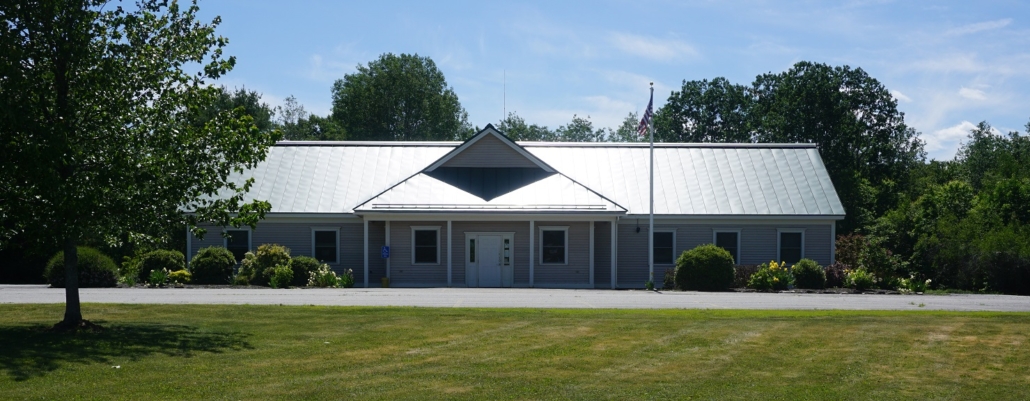Vassalboro planners hear intro to another solar development
 by Mary Grow
by Mary Grow
Vassalboro Planning Board members heard an introduction to another proposed solar development, by entities who have not previously worked in the town, at the Jan. 5 planning board meeting.
New England Solar Garden of Portsmouth, New Hampshire, was represented by Michael Redding. Sebago Technics, of South Portland, was represented by Owens McCullough. Sebago Technics is a civil engineering and land development consultant firm that works with developers like Solar Garden; Solar Garden specializes in community solar development.
Redding explained that the project will be on almost 30 acres of leased land. The land is on the west side of Cemetery Street, not far north of the Matthews Avenue intersection. Town tax records list Nicholas R. and Katie D. Jose as the land-owners; access will be by an existing gravel road that crosses Raymond Alley’s property.
The area is currently forested and appears to have been harvested in the past. It will be clearcut and stumps removed and will become meadowland, Redding said.
Fixed, south-facing solar panels will be placed in rows. Redding said the bottom edges of the panels will be about six feet off the ground and the upper edges about 12 feet above ground level.
The connection to Central Maine Power Company’s grid will be at the CMP power line, between the site and the street; there will be no need for extra poles on the street. A tree buffer at least 30 feet wide will line the south, west and north sides of the solar array, making it nearly invisible to passers-by.
Instead of the more usual chainlink fence, Solar Garden will put up an eight-foot- high knotwire fence, which has wider holes and is commonly used to keep deer out of orchards. This fence lets turtles, snakes, chipmunks, mice and other small animals through. Larger holes will be made to allow raccoons and foxes as well, so the solar array will not become “a resort for smaller mammals,” Redding said.
Local fire and law enforcement personnel will have the means to get through the gate in an emergency. Redding said his company will provide training for firefighters if asked.
The meadow will be planted with native plants, including some likely to attract native pollinators like bees and moths, and mowed no more than twice a year. This kind of habitat might attract such endangered species as cottontail rabbits, ribbon snakes and Blanding’s turtles, Redding said.
McCullough’s firm is responsible for obtaining permits. He expects the Maine Department of Environmental Protection’s site location permit, for which he intends to file in a few weeks, will take several months. He also has checked with state agencies that deal with natural resources, historic preservation and other relevant issues.
McCullough and Redding said it appears the solar development will have minimal impact on the local environment. During construction there will be some noise as supports are pounded into the ground. When the project is operating, Redding anticipates little noise – perhaps “a low hum” from three transformers.
The project has no buildings, uses no water, generates no sewage or waste, has no outdoor lighting and will have little traffic. A nearby snowmobile trail will not be affected. Studies of similar projects elsewhere have shown no negative impact on nearby property values and sometimes a positive impact, McCullough said.
Final documents will include a decommissioning plan and a bond to cover decommissioning costs if necessary. Redding said the panels are guaranteed for 30 years and might well last twice that long. They will be monitored and any damage – for example, from a tree limb blown down by wind – repaired.
Planning board members made sure Redding and McCullough knew what they need to include in a full application, which is likely to be presented at the March planning board meeting (normally, Tuesday evening, March 2). Codes Officer Paul Mitnik said he will provide a list of abutters who need to be notified of the application.
Redding said if all permits are in hand by the beginning of July, construction could start in August and be finished in the fall.
In other business, board members briefly discussed proposed revisions to Vassalboro’s marijuana ordinance and arranged with Vassalboro Community School Technology Director David Trask to be participants in the Jan. 7 selectmen’s meeting. The marijuana ordinance is a selectmen’s responsibility.
Planning board member Douglas Phillips said he thinks board members need to start making site visits more often before they review applications, to confirm the accuracy of information submitted.
Mitnik said he is taking advantage of a seasonal lull in permit applications to update the list of subdivisions in Vassalboro. He estimates there are at least 70, some dating from the early 1970s. Under the town ordinance, any change in a subdivision, like dividing a lot or relocating a lot line, requires planning board approval.
The next regular planning board meeting would be Tuesday evening, Feb. 2. However, Mitnik said unless he receives an unexpected application, he sees no reason to meet.
Responsible journalism is hard work!
It is also expensive!
If you enjoy reading The Town Line and the good news we bring you each week, would you consider a donation to help us continue the work we’re doing?
The Town Line is a 501(c)(3) nonprofit private foundation, and all donations are tax deductible under the Internal Revenue Service code.
To help, please visit our online donation page or mail a check payable to The Town Line, PO Box 89, South China, ME 04358. Your contribution is appreciated!





Leave a Reply
Want to join the discussion?Feel free to contribute!